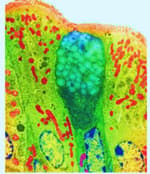Debora M Primrose Solutions for Chapter: Cell Biology, Exercise 7: Practice problems for Topic 1
Debora M Primrose Biology Solutions for Exercise - Debora M Primrose Solutions for Chapter: Cell Biology, Exercise 7: Practice problems for Topic 1
Attempt the practice questions on Chapter 1: Cell Biology, Exercise 7: Practice problems for Topic 1 with hints and solutions to strengthen your understanding. Oxford IB Prepared Biology IB Diploma Programme solutions are prepared by Experienced Embibe Experts.
Questions from Debora M Primrose Solutions for Chapter: Cell Biology, Exercise 7: Practice problems for Topic 1 with Hints & Solutions
The electron microscope shows a section of the epithelium of the small intestine. Identify two structures present in these cells that show they are involved in the uptake of food.

Glucose is a six-carbon sugar that provides the energy needed by cells. Because glucose is a large molecule, it is difficult for it to be transported across the membrane through simple diffusion. Explain how glucose is transported into a cell such as a red blood cell down a concentration gradient.
Describe the experimentation that led to the proposal of the Davson-Danielli model of the cell membrane and its later falsification leading to the Singer-Nicolson model.
Outline the process of endocytosis.
Describe the experiment of Miller and Urey into the origin of organic compounds.
Cells go through a repeating cycle of events in growth regions such as plant root tips and animal embryos. Outline this cell cycle.
